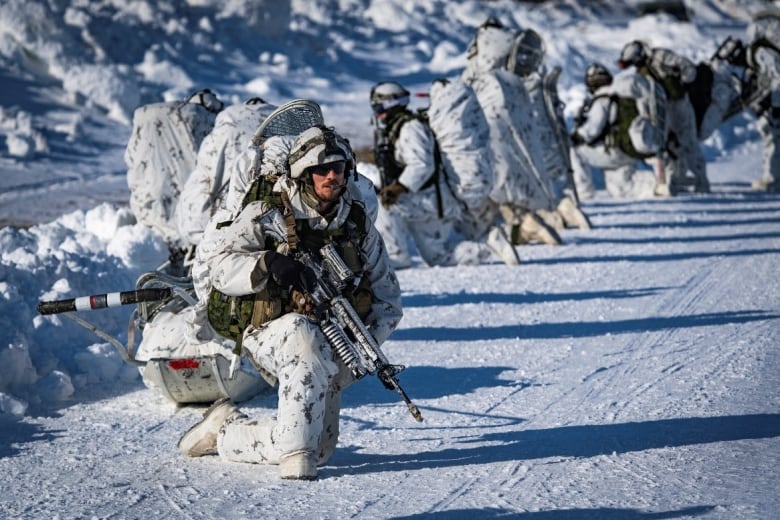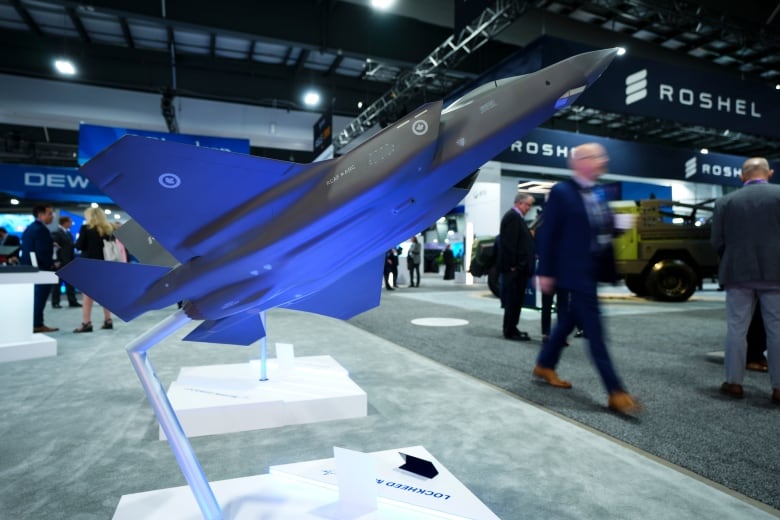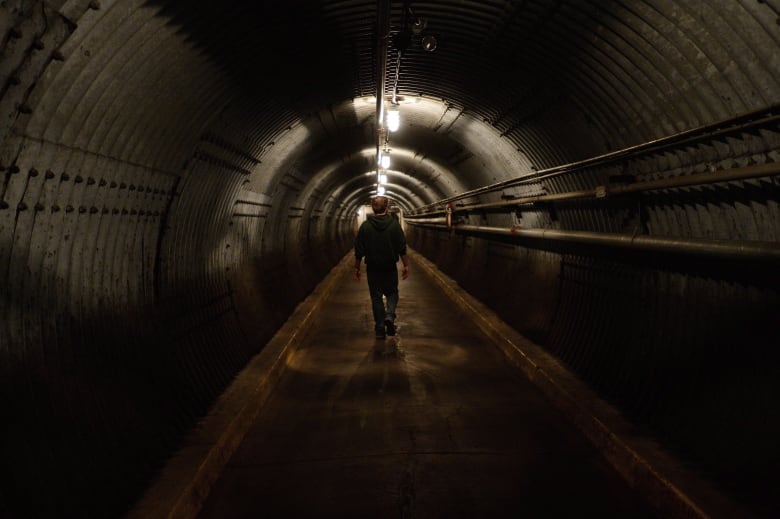Thinking the 'unthinkable': NATO wants Canada and allies to gear up for a conventional war
NATO's call for defence industrial strategies pulls Canada into a conversation it has avoided for decades

NATO says it wants its members to develop national plans to bolster the capacity of theirindividual defence industry sectors, a concept Canada has struggled with or avoided outright for decades.
At the NATOleaders summit in Washington in July, alliance members agreed to come up with strategies to boost their domestic defence materiel sectors, and to share those strategies with each other. Almost entirely overshadowed at the time by debates about members' defence spending and support for Ukraine, the new policy got little attention.
Federal officials are just beginning to wrap their heads around the ramifications of the new policy, and the burden it could placeon the government and Canada's defence sector.
And CBC News has learned that Ottawa has little in the way of institutional knowledge or Cold War-era mechanisms on which to fall back. For decades,the federal government has lacked an across-the-board plan to fully mobilize the country, federal institutions and the economy to fight a conventional warthe kind Ukraine is fighting now.

One former top national security official, several defence experts and a retired senior military leader all say that for the last 30 years,Canadians and their governments have been happy not to think about such things. Now, NATO is pressing the point.
"This is something we should definitely be thinking about, [but] I get why we kind of stopped thinking about this post-Cold War," said Vincent Rigby, a former national security and intelligence adviser to Prime Minister Justin Trudeau, referring to the decades of relative peace that followed the collapse of the Soviet Union.
Today following Russia's full-scale invasion of Ukraine he puts the odds of Canada being dragged into a major regional war in the next few years at 50-50.
One war, or many?
The threat of an armedconfrontation between western allies and Russia or China (or both) hangs over Canada, Rigbysaid, and the country still doesn't have a national security strategy, a formal foreign policy or a defence industrial policy.
"Given the state of the world, we have to have contingency plans in place," he said. "And we are living in a world where it may not be a nuclear conflagration.
"The next big war, it'll be a series. It will be a big regional war,or a series of regional wars, that Canada will be drawn into as a Western ally. Sowe better have our plans in place, including for mobilizing industry."
The Department of National Defence was vague when it was asked recently what measures are being taken to address the new NATO commitment. It mostly pointed to the rewritten national defence policy, which promises the Canadian Armed Forces will be able "to generate and employ highly capable forces to meet crisis situations at home and abroad."
The department has long-standing plans on the shelf to mobilize soldiers in the event of war.
For decades, the defence department broke mobilization down into four phases, according to the 1994 Defence White Paper.
Stages one through three involved maintaining and training forces, and gradually calling up and equipping reserve troops to augment and expand the army, navy and air force. All three branches of the Canadian Forceshad well-defined federal plans.
The fourth stage involved "full national mobilization," which "would touch on all aspects of Canadian society" and be invoked in the event of war and the declaration of the Emergencies Act, the white paper said.The federal government had no detailed plan for that eventuality in 1994, although officials warned at the time that it "remains prudent to have 'no-cost' plans ready for total national mobilization," despite the era of relative international stability that was dawning.

No such total mobilization plan was ever drafted, according to retired lieutenant-general Guy Thibault, a former vice chief of the defence staff. He said many plans "withered on the vine" during the 1990s as the federal government went through a painful budget-cutting exercise that left the military scrambling to preserve the basics.
"We were all focused on really squeezing as much juice as we could out of an ever decreasing size of the force," said Thibault, who retired in 2016 and now heads the Conference of Defence Associations Institute.
While the 2014 Russian invasion of Crimea served as a wake-up call, Thibault said that even at that time, no one was talking about "mobilizing society towards scenarios that were kind of unthinkable."
The federal government'snew defence policy acknowledges the need to build up Canada's defence industrial base. Butsince the Russian invasion of Ukraine, the federal government has struggled to boost something as simple as ammunition production.

There's a long-standing aversion within the federal government to being seen working cooperatively with defence contractors, said the head of the association representing defence manufacturers.
"The Canadian government has long been an outlier internationally in its unwillingness to work in partnership with its domestic defence industry," Christyn Cianfarani, president of the Canadian Association of Defence and Security Industries, told the House of Commons defence committee on Tuesday.
She said that with this new policy,NATO has formally acknowledged that having each member contributeto the steady flow of arms and munitions represents "a new element of NATO burden-sharing."
'We are not on a war footing'
While he was still in uniform, now-former chief of the defence staffWayne Eyrerepeatedly warned Parliament and thepublic that the country's defence industry is ill-prepared for what may lay ahead, and the nation's munitions makers need to get"on a war footing."
That hasn't happened.
"We are not on a war footing whatsoever," Cianfarani told the four-party Commons committee.
"I mean, we are just not in a state of high alert, and we are not operating with a sense of urgency that we see other partners ... operating with."
Steve Saideman, a professor who holds the Paterson Chair in International Affairs at Carleton University, said that given the federal government's reluctance to publicly commit to a target date for reaching NATO's two per cent benchmark, he questions how much effort it will put into the new defence industrial pledge.
"I think for the past 30-plus years, we've all been quite happy not to think about such things, and it's been hard to get government to focus on long-term objectives or dynamics like this," Saideman said, adding this has been the attitude of both Liberal and Conservative governments.
While the Defence Production Act a rarely invoked piece of legislation grants the defence minister extraordinary powers in wartime, Saideman said, "we don't have a good mechanism, at least as far as I can tell, for having cooperation between industry and the government so that they can make commitments to be able to turn a switch and change things around."
Ukraine has suffered horrendous losses of manpower and equipment fighting off the Russian invasion and has scrambled for replacements. Saideman said he hopes that is being noted by both the federal government and the defence industry.
"If we got into a serious shooting match with either China or Russia, we'd lose ships, and that would require replacement faster than the replacement ships that we've been doing right now," he said, referringto the navy's long-delayed frigate replacement program.
"That goes for planes, that goes for everything. But one of the challenges is we have to figure out something really hard, which is, how do we do quantity in the 21st century? Our procurement has been about quality,about getting the best possible equipment, and having a few of those around that can do as many things as possible."

Saideman said he questions whetherCanada could mobilize itself for war today, the way it didduring the Second World War.
"I just don't see Canada having that capacity," he said.
But even in the depths of the Cold War, nobody in the federal government was thinking about mobilizing for a conventional war, said military historian Sean Maloney.
"In the 1950s, the dominant war plans with the U.S. and Canada within NATO all revolved around nuclear weapons," said Maloney, who noted the Conservative government at the time fully expected any war with the Soviet Union to go nuclear at the outset, with defence industries being major targets.
"Under the Diefenbaker government, they wondered why [they would] even bother attempting mobilization under those conditions, either industrial mobilization or force structure mobilization."

Maloney said thathelps to explain the lack of planning back then. But given thewar in Ukraine, Ottawa no longer has an excuse.
"The idea that everything's going to be a runaway nuclear escalation has been proven false over the past two years," said Maloney. Like Saideman, he said hedoubts Canada could pull off what it did during the Second World War,either at an institutional or asocietal level.
"We're drowning in red tape. The level of regulation stifles innovation. It stifles creativity," Maloney said in reference to the federal government's overall handling of industry.
"The population is so divided about what it wants, or what it thinks it wants, it can't process the strategic realities we're dealing with right now."
Ukraine, Maloney said, has demonstrated that you need national will in order to fight.
"It is absolutely fundamental to any effort that you're talking about," he said. "And it does not exist in thiscountry, either at the elected political level, in the bureaucracy or the population."












_(720p).jpg)


 OFFICIAL HD MUSIC VIDEO.jpg)
.jpg)



























































































